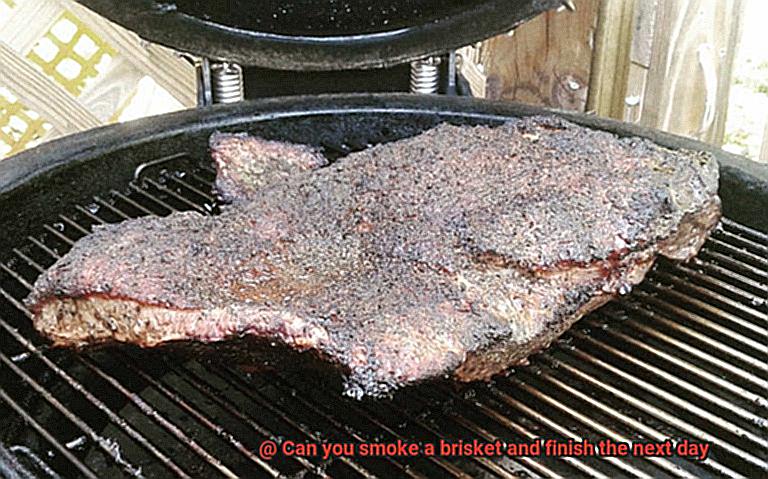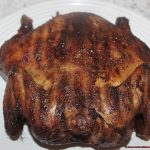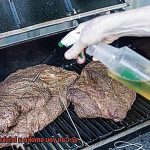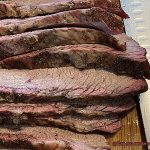Imagine the tantalizing aroma of a perfectly smoked brisket, slow-cooked for an entire day, infused with the rich flavors of hickory, applewood, or mesquite. It’s enough to make your mouth water and your heart skip a beat. But what if you can’t finish it all in one day? Don’t worry; smoking a brisket and finishing it the next day is entirely possible.
In fact, many pitmasters swear by this method as it allows for better control over the cooking process. Smoking a brisket takes time, and interruptions can happen. By splitting up the cook into two parts, you can ensure that your meat remains juicy and tender without drying out or overcooking.
So how do you go about smoking a brisket one day and finishing it the next? In this post, we’ll delve into the nitty-gritty details of proper storage techniques and reheating methods to keep your brisket moist and flavorful throughout the entire process.
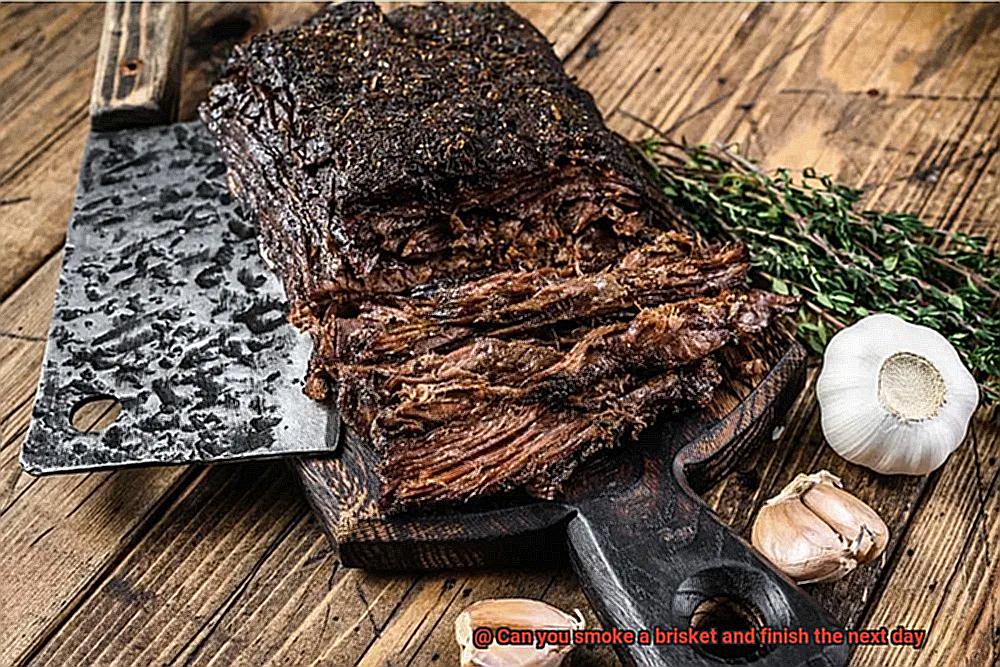
Whether you’re hosting a backyard barbecue or just looking to satisfy your carnivorous cravings, smoking a brisket is an art form that requires patience and care. So grab yourself a cold beer, crank up some tunes, and join us as we explore everything you need to know about smoking a brisket today and finishing it tomorrow.
Contents
The Time-Consuming Process of Smoking a Brisket
Smoking a brisket is a culinary journey that takes time and dedication. It’s an art form that requires careful monitoring of temperature and smoke levels to achieve the perfect balance of tenderness, flavor, and juiciness. Let’s take a closer look at the time-consuming process of smoking a brisket.
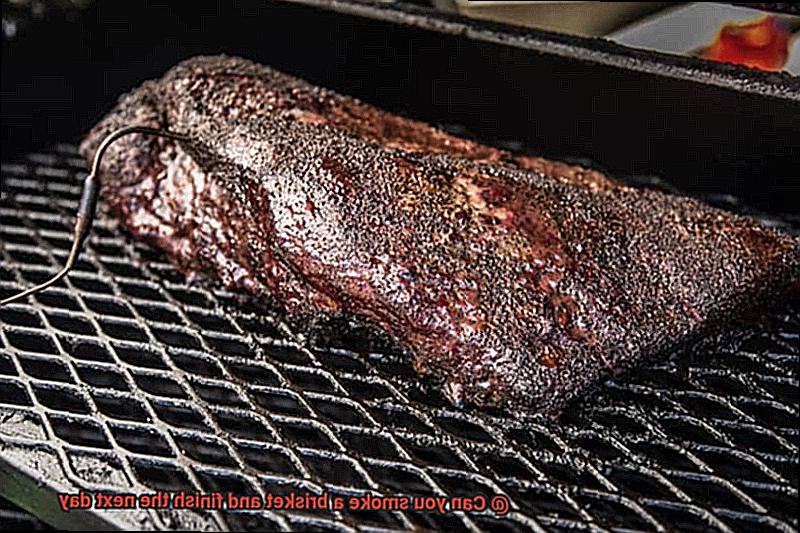
Firstly, it’s important to understand that smoking a brisket takes time because it’s a tough cut of meat that requires slow cooking to break down the connective tissue and fat. Depending on the size of the brisket, this can take up to 12 hours or more. So, if you plan to serve it for dinner, you need to start early in the morning.
To begin, you’ll need the right tools, including a smoker, wood chips or chunks, a meat thermometer, and plenty of patience. Before smoking the brisket, you’ll need to trim off excess fat and season it with your favorite dry rub or marinade. Then place it on the smoker grates and let it smoke for several hours until it reaches an internal temperature of around 200°F.
Once the brisket is fully cooked, remove it from the smoker and let it rest for at least 30 minutes before slicing it. This allows the juices to redistribute throughout the meat, resulting in a more flavorful and tender final product.
If you want to finish smoking the brisket the next day, there are two methods you can use. First, smoke the brisket for several hours on the first day and then wrap it in foil or butcher paper and refrigerate it overnight. The next day, finish smoking the brisket until it reaches the desired internal temperature.
Alternatively, after several hours of smoking on the first day, transfer the brisket to a slow cooker to finish cooking overnight. This method results in a more tender and juicy brisket as the meat cooks in its own juices.
However, storing the brisket overnight can affect the texture and taste of the meat. It may become slightly mushy and lose some smoky flavor. To minimize these effects, it’s recommended to finish cooking the brisket as soon as possible after smoking it.
Storing the Brisket Overnight: Pros and Cons
Let’s take a closer look at the pros and cons so you can make an informed decision.
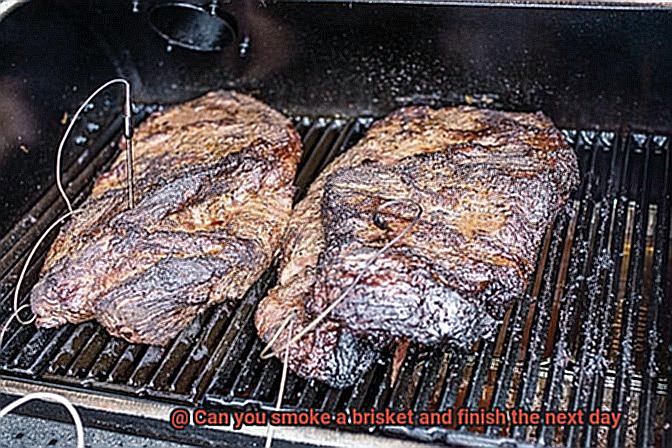
First, the advantages. Storing your brisket overnight allows it to rest and absorb more flavor, resulting in a tender and more flavorful final product. This is because the juices from the brisket will redistribute throughout the meat during the resting period. Additionally, storing your brisket overnight provides more flexibility in your cooking schedule, which can be helpful if you have a busy day ahead.
However, there are also potential downsides to consider. Improper storage may cause your brisket to dry out or become tough. To avoid this, wrap it tightly in foil or plastic wrap and store it in the refrigerator as soon as possible after cooking. Another potential issue is that the brisket may continue to cook in its own residual heat, leading to overcooking or drying out. Consider taking it out of the smoker a bit earlier than usual and allowing it to finish cooking slowly in the refrigerator.
To sum up, storing your brisket overnight can be a great option for achieving a delicious end result. Here’s a quick list of pros and cons to consider:
Pros:
- More tender and flavorful final product
- Increased flexibility in cooking schedule
Cons:
- Risk of drying out or becoming tough if not stored properly
- Potential overcooking or drying out if residual heat continues to cook the brisket
Reheating the Brisket for Finishing
I am here to guide you through the crucial step of reheating your brisket for finishing.
First things first, proper refrigeration is key to avoid bacterial growth. Once that’s taken care of, you can proceed with reheating your brisket in two different ways.
- Option one: Oven Reheating. This method involves wrapping your brisket tightly in foil and placing it in an oven set at 250-275°F for about an hour, or until the internal temperature reaches 165°F. This technique helps retain moisture and is easy to do in your home oven.
- Option two: Smoker Reheating. For those who want a more smoky flavor, place the brisket back in the smoker at a low temperature (around 225°F) and smoke it until it reaches an internal temperature of 165°F. This method takes longer but gives the brisket more depth of flavor.
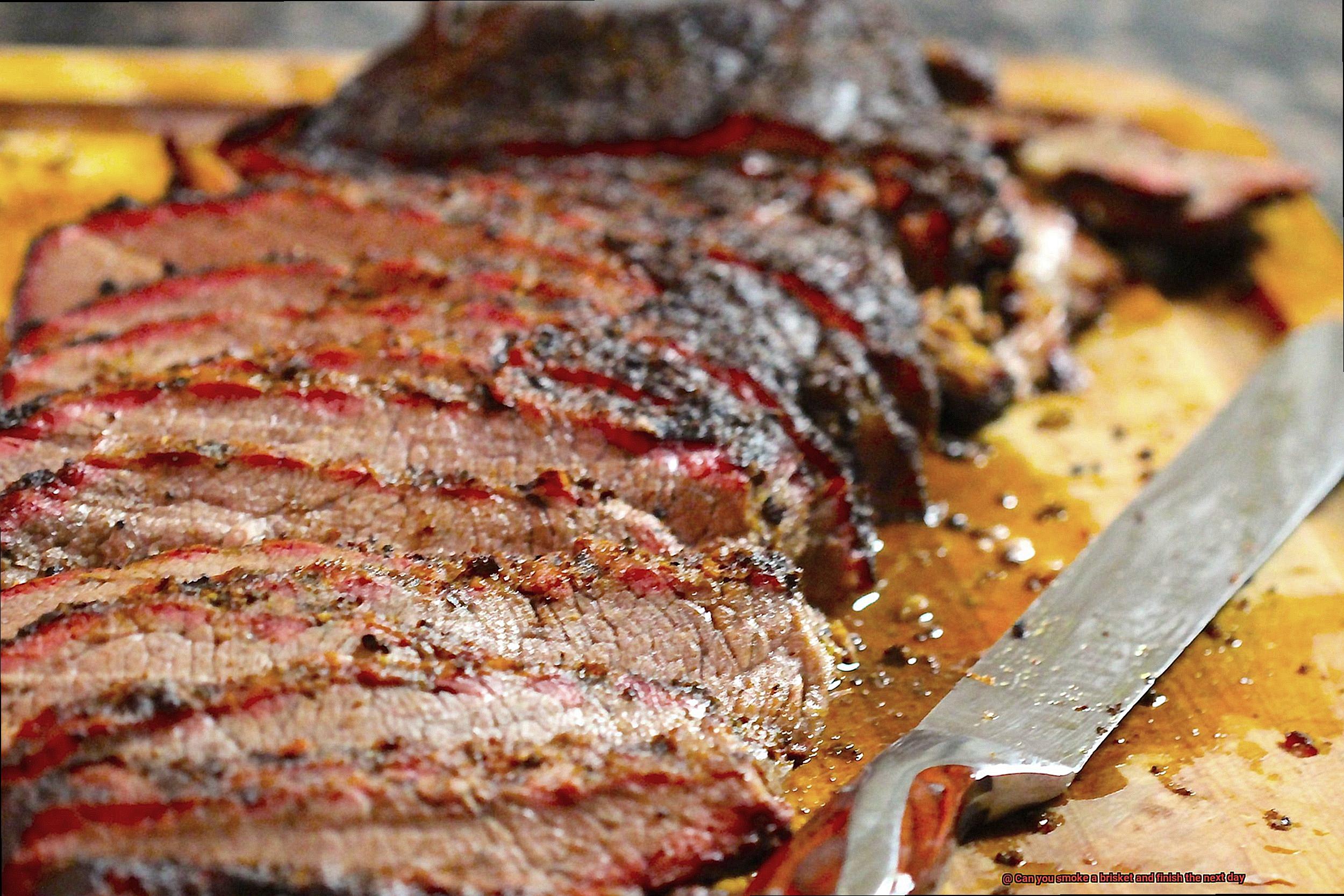
Whichever option you choose, keep an eye on the internal temperature of your brisket to avoid overcooking and drying it out. And once it’s heated, let it rest for about 10-15 minutes before slicing and serving to allow the juices to redistribute.
It’s important to note that reheating your brisket may result in slightly different texture and flavor compared to when it was first smoked. However, with proper technique, it should still be delicious and satisfying.
To ensure you always have a successful reheated brisket experience, here are a few additional tips:
- Don’t forget to remove the brisket from the refrigerator at least an hour before reheating to allow it to come to room temperature.
- Avoid using a microwave to reheat your brisket as it can result in uneven heating and tough, chewy meat.
- If you’re using the oven method, you can add a bit of beef broth or apple juice to the foil-wrapped brisket to help keep it moist.
Preparing the Smoker for Smoking a Brisket
Smoking a brisket is an art form, and it all starts with properly preparing your smoker. As an expert in this area, I’m here to guide you through the crucial steps to ensure your brisket comes out perfect every time.
Firstly, decide on the type of smoker you’ll be using – electric, gas, or charcoal. Once that’s settled, it’s time to get your hands dirty.
Start by giving your smoker a thorough cleaning to avoid any lingering ash or debris from the previous smoke interfering with your delicious brisket. Don’t forget to check and refill the water pan.
Now it’s time for the fun part – choosing your wood chips or chunks. Do you prefer the bold flavor of hickory, the subtle sweetness of applewood, or something in between? Whatever your choice, soak them in water for at least 30 minutes before adding them to the smoker.
Once everything is prepped and ready to go, preheat your smoker to between 225-250°F – the ideal temperature for a brisket. Maintaining a steady temperature is essential, so keep an eye on it throughout the smoking process and make adjustments as necessary by adding more charcoal or wood.
Finally, place your brisket on the grates and let it work its magic. Be sure that the meat doesn’t touch any part of the smoker to ensure even cooking. If you plan on finishing your brisket later, smoke it for about half of the recommended cook time on the first day and finish it off in your oven or smoker the next day.
In summary, here are the key steps to prepare your smoker for smoking a brisket:
- Clean and maintain your smoker.
- Choose your wood chips or chunks and soak them in water.
- Preheat your smoker to between 225-250°F.
- Maintain a steady temperature throughout the smoking process.
- Place your brisket on the grates and smoke away.
Selecting the Right Cut of Meat
First and foremost, the packer’s cut is the ideal choice for smoking a brisket. This cut includes both the point and flat portions of the brisket, providing a more even thickness throughout the meat and allowing for more consistent cooking. Additionally, the packer’s cut has a higher fat content, thanks to more marbling, which helps keep the meat moist during the long smoking process.
Speaking of fat, it’s important to select a brisket with a good amount of fat on one side, commonly known as the “fat cap.” This layer acts as a natural barrier against drying out and imparts additional flavor and moisture to the meat as it renders down during cooking.
Size also matters when it comes to selecting the right brisket. Opt for a cut that weighs at least 10-12 pounds to allow for longer smoking times without drying out the meat. And don’t forget to choose a brisket that has been aged for at least 21 days – this process helps break down connective tissue and make the meat more tender.
Seasoning and Rubbing Techniques
In this section, we will dive into the art of seasoning and rubbing techniques that are essential for creating a delicious smoked brisket.
The first step in creating the perfect rub is selecting the right spices. While classic spices such as salt, black pepper, garlic powder, onion powder, chili powder, paprika, and cumin are commonly used, feel free to experiment with different spice combinations to find your perfect flavor. Whether you prefer a spicy kick or a more subtle taste, the right combination of spices can enhance the natural flavor of your brisket.
Once you have selected your spices, it’s time to apply the rub to your brisket. To ensure even seasoning, be sure to coat all sides of the meat generously. Some experts suggest applying the rub the night before smoking to allow the flavors to penetrate deeper into the meat. Alternatively, if you’re pressed for time, applying it just before smoking will still give you a mouth-watering result.
A great technique for getting your rub to adhere well to the meat is to use a binder such as mustard or olive oil. This not only helps the rub stick better but also adds an extra layer of flavor to your brisket.
In addition to selecting the right spices and properly applying the rub, don’t forget about the importance of balancing flavors. For instance, if you prefer a sweeter taste, consider adding brown sugar or honey to your rub mixture.
Finally, keep in mind that there are multiple ways to apply your rub. You can use a shaker or simply sprinkle it by hand. Whatever method you choose, ensure that each inch of your brisket is seasoned evenly.
Maintaining Temperature Control During Smoking
Then, it’s time to master the art of temperature control during smoking. Consistent temperatures throughout the entire smoking process are critical to creating a mouth-watering brisket that’s bursting with flavor. With these simple steps, you’ll achieve temperature nirvana and be on your way to impressing everyone with your smoking skills.
First, invest in a high-quality smoker that is designed to keep temperatures consistent. Electric smokers are often the best option for maintaining temperature control because they have precise temperature controls and are easy to use. They reduce the need for constant monitoring, so you can spend more time enjoying your brisket and less time fussing over the fire.
Next, choose the right type of fuel. Wood pellets and charcoal are popular choices for smoking brisket, but they burn at different temperatures and produce different levels of smoke. It’s important to choose the right type of fuel and monitor it closely during the smoking process. Remember that consistency is key.
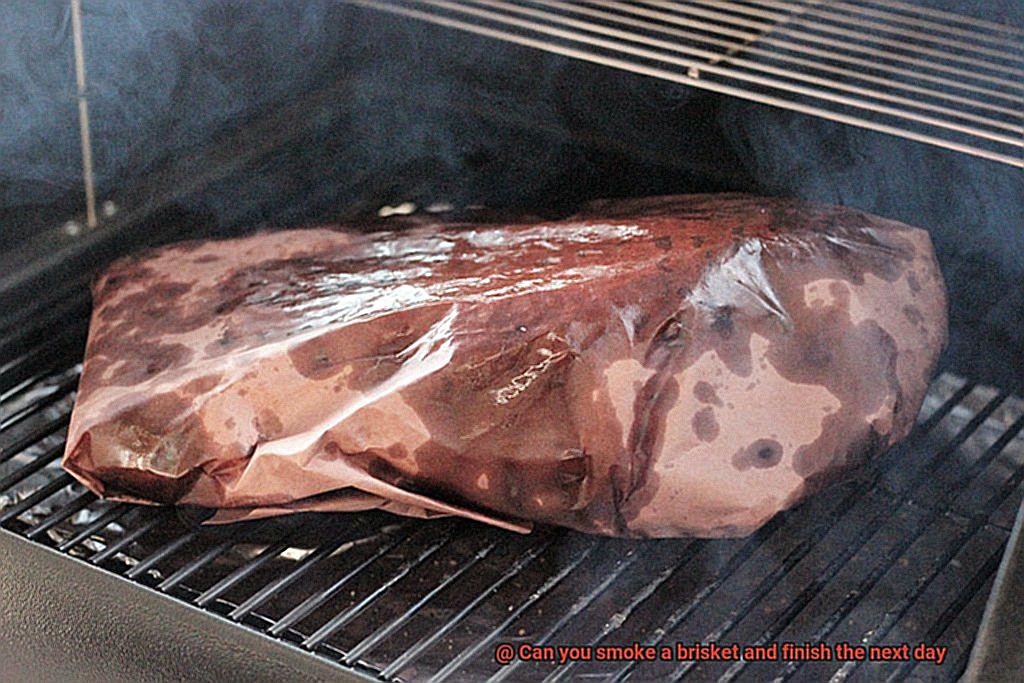
Monitoring the internal temperature of your brisket is also crucial. A meat thermometer is an essential tool for monitoring the internal temperature of the brisket. When the internal temperature reaches 160°F, it’s time to wrap the brisket in foil or butcher paper to prevent it from drying out.
If you plan on finishing your brisket the next day, it’s important to cool it down quickly after smoking to prevent bacteria growth. Once cooled, wrap it tightly in foil or butcher paper and store it in the refrigerator overnight.
On the day of, let your brisket come up to room temperature before placing it back in the smoker. Monitor the internal temperature of the brisket throughout this process and adjust the smoker’s temperature as needed. Remember that patience is key when smoking a brisket – slow and steady wins the race.
To recap, here are some key factors in maintaining temperature control during smoking:
- Use a high-quality smoker designed to keep temperatures consistent
- Choose the right type of fuel and monitor it closely
- Monitor the internal temperature of the brisket with a meat thermometer
- Cool down the brisket quickly after smoking to prevent bacteria growth
- Let the brisket come up to room temperature before placing it back in the smoker
Wrapping the Brisket After Smoking
If so, pay attention because wrapping your brisket after smoking is a crucial step in creating a tender and juicy finished product. But what about those times when you need to finish smoking your brisket the next day? Fear not, we’ve got all the expert tips you need to know.
Let’s start with the two most popular options for wrapping your brisket: butcher paper and foil. Butcher paper is a fantastic choice as it allows for some airflow while still retaining moisture. However, if you plan to finish smoking your brisket the next day, ensure that you wrap it tightly in butcher paper and store it in the refrigerator overnight. This will prevent bacterial growth while allowing all the different flavors to meld together.
Alternatively, foil creates a more airtight seal which can help retain even more moisture. If you opt for this method, make sure to let your brisket cool down for a bit before wrapping it to prevent steam from building up and making the meat soggy. Again, if you plan to finish smoking your brisket the next day, wrap it tightly in foil and store it in the refrigerator overnight.
Regardless of which wrapping method you choose, reheating your brisket slowly and gently is paramount to ensure it doesn’t dry out. You can do this by using an oven set at a low temperature or a smoker set at a low temperature. Take your time and be patient – it may take several hours for the brisket to fully heat through, but trust us, it’s worth it.
BHIDWWMPJu0″ >
Conclusion
In conclusion, smoking a brisket and finishing it the next day is not only possible but can also result in a more tender and flavorful final product. However, proper storage techniques and reheating methods are crucial to achieving this delicious outcome.
Smoking a brisket is an art that requires time, patience, and dedication. It involves carefully monitoring temperature and smoke levels to achieve the perfect balance of tenderness, flavor, and juiciness. But storing the brisket overnight has its pros and cons.
On one hand, it allows for more flexibility in your cooking schedule. On the other hand, improper storage may cause your brisket to dry out or become tough. That’s why you need to follow expert tips on how to wrap and store your brisket properly.
Reheating the brisket for finishing is another crucial step that requires proper refrigeration to avoid bacterial growth. You can either use oven reheating or smoker reheating techniques depending on your preference.
Selecting the right cut of meat, seasoning, rubbing techniques, maintaining temperature control during smoking are all essential steps in creating a mouth-watering smoked brisket that’s bursting with flavor. With these expert tips at hand, you’ll be able to impress everyone with your smoking skills.
In summary, smoking a brisket is a labor of love that pays off with every succulent bite. By following these tips on how to store and reheat your smoked brisket properly, you can enjoy its full flavor potential even after it’s been smoked overnight.

